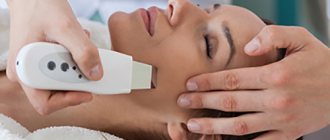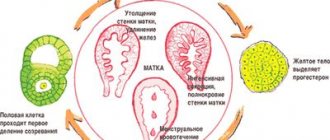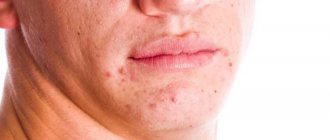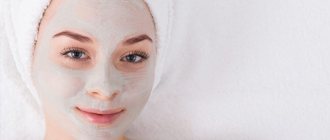A skin rash, especially on one side of the face, may be the result of poor hygiene or the presence of diseases of the internal organs. If your skin is dry, oily or covered in acne, you need to wonder what’s wrong with your body. Squeezing a pimple does not mean solving the problem, because without knowing the true cause of the rash, you can cause an infection and ultimately make the situation even worse.
Why does acne appear on the face?
Acne (pimples) is directly related to the active work of the sebaceous glands, hyperkeratosis, inflammation and increased colonization of propionibacteria. Excess sebum and dead epidermal cells clog pores, causing open (blackheads) and closed comedones to appear.
An inflammatory process may also begin in the skin, causing papules and pustules to appear. They can either independently or from comedones. Before deciding what to do with pimples* on the cheeks, you need to determine the cause of the rash, and there are several of them [4, 50]:
- Poor nutrition. Consumption of large amounts of fried, spicy, sweet foods, and dairy products increases the functioning of the sebaceous glands, causing rashes.
- Disruption of the digestive system. Allergies to certain foods and metabolic problems can cause rashes.
- Frequent stress and emotional overstrain. During stressful situations, the body produces large amounts of cortisol and adrenaline, which affect the functioning of the sebaceous glands.
- Insufficient or excessive hygiene, use of incorrect cosmetics. A connection has long been established between the appearance of acne and the use of certain types of cosmetics that are called comedogenic. They clog pores, causing acne*.
There are other reasons for the appearance of rashes on the cheeks - heredity, mechanical stress, bad habits, hormonal disorders. Sleeping on one side, using dirty makeup brushes or sponges, and the habit of constantly touching your face with your hands are all triggers for acne.
Pimples and blackheads on the face
There are teenage acne and adult acne (late). Juvenile acne on the face is localized mainly on the forehead, in the temporal areas, acne in adults is more often in the lower part of the face. Types of acne by location
• Acne appears on the face; • Temples; • Cheeks; • Back; • Breasts; • On the forehead; • Chin; • Nose.
Sometimes the localization of skin rashes can indicate to the doctor the connection between a skin disease and a problem inside the body, for example, in the gastrointestinal tract, or reveal a hidden process in the endocrine system, in the nasopharynx, etc. But to make a diagnosis only by the location of the acne, of course , it is forbidden. This is the basis for a more targeted examination.
Types of acne according to clinical picture:
• Non-inflammatory acne; • Inflammatory acne; • Non-inflammatory acne or blackheads are comedones.
Inflammatory acne is formed when microbes in the comedone are activated. Visible inflammation appears on the skin, many patients refer to it as acne vulgaris. In this case, severe forms of acne may develop. Pimples are bright red in color, painful, and can be large, deep, and resemble a boil. If left untreated, deep elements leave behind a scar. A separate type is rosacea (rosacea). They are characterized by persistent redness with a pronounced vascular pattern (especially in the cheek area). Against the background of redness, papules (small juicy nodules), sometimes “knots,” develop.
Why do acne appear?
The appearance of acne on the face does not always indicate the presence of some serious internal problems of the body; in some cases, the cause originates in external factors.
• The use of low-quality decorative cosmetics can cause skin irritation.
Untimely removal of makeup and the habit of going to bed with an uncleaned face have a particularly negative impact on health and beauty. Such a frivolous attitude leads to clogging of the pores and the development of all kinds of infections in them, resulting in the occurrence of acne.
•
Unhealthy environment.
People working in hazardous chemical industries know firsthand how acne on the face and the causes of their appearance in the form of irritating and even toxic effects of substances are interconnected. Working in such industries, you should pay especially close attention to skin hygiene and lead a healthy lifestyle so as not to aggravate the dangerous situation.
• Touching your face with dirty hands.
Sometimes even the cleanest person can accidentally spread an infection to the skin of the face by unknowingly touching it with unwashed hands. For those with sensitive, oily skin, this can be fraught with very unpleasant consequences, not only in the form of redness and irritation. Acne may also appear on the face.
Hormonal changes in the body
It is very common to observe acne on the face in adolescents, the causes of which are hormonal surges during puberty. If acne is mild and does not cause severe inflammatory processes on the skin, there is no cause for special concern.
This phenomenon is considered quite normal, and, subject to the rules of personal hygiene, acne will stop occurring as soon as the level of hormones in the body returns to normal.
A slight adjustment of nutrition helps in such cases. It is known that teenagers are partial to such harmful products as sugary carbonated drinks, chips, chocolate bars and all kinds of fast food. All these popular snacks are nothing more than food garbage, “dead” food, the consumption of which is detrimental to health at any age.
Hormones can “rage” not only during adolescence. Pregnancy, menopause, a short period of time before menstruation - all these time periods occur against a turbulent background, so acne may appear on women's faces.
What happens to the skin when acne appears?
By itself, acne is an accumulation of sebum around the hair follicle and further inflammation of this area of the skin. The fact is that with increased functioning of the sebaceous glands, the pores are often clogged, which prevents their free cleansing of excess fat. This is how acne forms. Inflammation is most often caused by erroneous actions taken by people themselves.
The causes of acne with an inflammatory process in them usually lie in attempts to roughly and unprofessionally get rid of the tubercles on their own, in other words, to squeeze them out. By doing this, it is impossible to solve the problem, and in most cases, such manipulations only add work to dermatologists, whom people who have suffered from their own frivolity turn to.
Why shouldn't you squeeze pimples?
The causes of acne on the face can be caused not only by external factors, by eliminating which you can solve the problem once and for all. Adjusting hormone levels is the work of an experienced doctor and can only be done under his supervision. In addition, if acne appears on the face, this may be an alarming signal from the body about the presence of some kind of disease, the treatment of which must begin immediately.
Often, acne can appear due to improper functioning of the gastrointestinal tract or pathologies of the pancreas, diabetes mellitus or liver disorders. It is simply impossible to treat such diseases on your own, and it makes no sense to carry out cleansing cosmetic procedures, especially squeezing acne, until the root of the problem is eliminated.
Squeezing pimples almost always causes the development of secondary infections in wounds, which entails the degeneration of ordinary comedones into inflamed and painful papules and purulent pustules.
If acne begins to appear all over your face, this is a reason to immediately consult a doctor, who should prescribe a full medical examination and appropriate treatment.
Treatment and tests are ANONYMOUS!
How to remove pimples* on the cheeks: treatment features
A cosmetologist or dermatologist can tell you how to get rid of acne* on your cheeks after conducting a diagnosis and determining the severity of the disease. For mild to moderate acne, topical medications are mainly used; with average – complex treatment is necessary; in severe cases, emphasis is placed on systemic therapy [18]. Auxiliary measures may also help:
- correction of diet and getting rid of bad habits;
- refusal of comedogenic cosmetics;
- stress reduction;
- carrying out special cosmetic procedures (peelings, cleansing, polishing).
Regardless of the location of the rashes, it is not recommended to remove them yourself. This can only worsen the condition, and a scar or pigment spot may appear in place of the pimple*.
How to treat?
You should not use medications if the exact provocateurs are unknown. Self-treatment can lead to marks and scars on the face.
If the examination does not reveal problems with organs, then the fight against rashes is carried out by normalizing nutrition.
Numerous rashes on the skin in 95% of cases provide the owner with information that something is wrong with his body. It is important to recognize the signal in time and rule out the disease by seeking help from a doctor. After conducting an examination and discovering the source of the disease, the doctor will prescribe the necessary treatment. If there are no health problems, a lifestyle review will help get rid of acne:
- Change your diet. It is important to exclude flour and sweets, eat more vegetables, herbs and fruits.
- Reinforce the body. Take a vitamin complex if your immune system is weakened.
- Pay attention to hygiene and care products. The rash may be an allergic reaction to cosmetics. Folk beauty recipes can also help remove acne - frozen cubes from herbal infusions, clay masks.
- Quit smoking and reduce alcohol consumption to a minimum.
To treat acne at the pharmacy, dermatologists recommend buying ointments - “Baziron”, “Skinoren” or “Zinerit”. Each person chooses the most comfortable facial care for himself and cosmetologists can help in treating problem areas. Specialists offer cosmetic laser correction procedures, Botox injections and other manipulations that reduce inflammation and eliminate the effects of acne. Thanks to several sessions, you can smooth and rejuvenate the skin, discolor scars and scars.
Pimples* on the cheeks: which organ can hurt?
There is an opinion that there is a connection between the location of the rashes on the face and the functioning of the organs, that is, by the pimples* on the cheeks it is determined which organ is suffering. And this is what the rashes in this zone mean [208]:
- disturbances in the functioning of the stomach (pimples* are located under the cheek line);
- lung diseases (inflammation is localized in the middle and lower parts);
- diseases of the gums and teeth (rashes in the lower part).
In addition, rashes on the cheeks may indicate a lack of positive emotions and lack of oxygen. But there is no scientific evidence that acne* on the cheeks and the functioning of organs are connected.
Causes of acne
Often, the appearance of acne on the face of teenage boys and girls will not surprise anyone. Hormonal changes in a young body are typical between the ages of 13 and 16 years. But when adolescence is behind, the appearance of a rash, in addition to aesthetic discomfort, causes other concerns. Negligent attitude and lack of facial skin care leads it to a state of inflammation, pollution and clogged pores.
The main reasons for violations of hygiene rules are:
- Washing every other time or, conversely, frequent facial cleansing procedures, as well as the use of one towel by several people.
- Using cheap cosmetics and/or not washing them off before bed.
- Untreated cuts after shaving.
The cause of an unexplained rash on the face may be:
- Diseases of internal organs and metabolic disorders.
- Hormonal imbalance mainly affects the female sex during pregnancy, menopause, and before menstruation.
- Taking hormonal and contraceptive medications.
- Depression or stress.
- Excessive consumption of medications, sweets or carbonated drinks.
Talking on the phone for a long time and constantly holding it on one side can cause acne formation.
Sometimes it is observed that acne on the face is concentrated on the right or left side, while the other side remains clear. An unexpected factor in infections are things that are used in everyday life:
- Pillow and habit of sleeping on one side every night, for example, on the left side. Down or feathers inside can be a breeding ground for microorganisms and cause an allergic reaction from this side.
- Dust and dirt on a cell phone, as well as long conversations and the formation of sweat on the cheek can contribute to the development of bacteria and inflammation, usually on the right side.
Localization
Many years ago, the sages of ancient China learned to determine the presence of internal diseases by the appearance of pimples on the face in certain places. It is worth paying attention to the pimples that often appear on the left side of the cheek - they reflect the condition of the liver. There is an area of nasolabial folds close to the cheeks and a rash on them indicates a disease of the ureters (asymmetric to the placement of the organs). By conditionally dividing the face into zones, you can understand which organ needs to be checked. Experts have collected possible options, which are presented in the table:
| Face area | Localization | High probability of organ disease |
| Forehead | Immediately under the hair on top and in the temple area | Gallbladder |
| Just below | Colon area | |
| In the middle of the forehead | Small intestine | |
| Glabella | Liver | |
| Nose | Bridge and wings of the nose | Hormonal imbalance (certain age or condition, stress, medication) |
| On the tip | High blood pressure, pay attention to the heart | |
| On the back | Stomach or pancreas | |
| Chin | In the middle | Excess androgen in the blood, diseases of the genital organs, nervous condition or weakened immunity |
| Bottom part | Endocrine system (thyroid gland, adrenal glands, pituitary gland) | |
| Lips | Above the lips | The cardiovascular system |
| On the corners and upper lip | Duodenum | |
| Central part of the lower lip | Small intestine | |
| Along the edges of the lower lip | Colon | |
| Around the lips | Intestinal slagging | |
| Eyes | Around eyes | Diseases of the genitourinary organs |
| Cheeks | Upper cheek | Sick stomach |
| On the cheeks themselves | Respiratory diseases | |
| At the bottom of the cheeks (along the face line) | Oral diseases | |
| From the wings of the nose to the cheeks | Problems with the bronchi |











